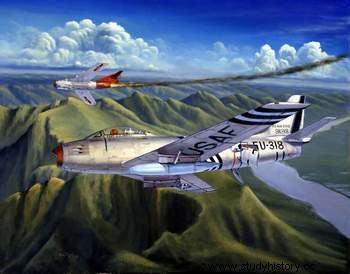
Among the many nicknames given to the North American F-86 Saber in During its long career, that of "Mig Killer", that is to say killer of Mig, gives, perhaps more than the others, an idea of its success as a fighting machine. The first swept-wing jet fighter to be adopted by the USAF, the Saber was also — in many ways — the last of the “classic” fighter aircraft:highly maneuverable, fast, powerful, ideal for close combat. These characteristics became indisputable in Korea when the F-86s managed to regain air supremacy over the Soviet M1G-15s, which had proven to be clearly superior to the Lockheed F-80s. In addition to an excellent combat machine, the Saber also constituted a great commercial success for American industries:the United States built the various versions in thousands of copies distributed, in fact, to all the member countries of NATO and to many "non-aligned" countries - to which were also added the F-86 produced under license in Canada, Australia, Japan and Italy. In the latter case, Fiat produced, in the mid-1950s, 221 examples of the "all-weather" version F-86K, of which 63 went to the Italian Military Aviation, 60 to France, 88 to Federal Germany. . 6 in the Netherlands and 4 in Norway. From 1956, in addition to the F-86K, the Italian military aviation put into service, in particular, the Sabers of the E version, built under license by Canadair.
The origins of the project date back to 1944. At that time, the North American was already studying a jet fighter (XFJ-1 Fury) intended for the US Navy and was also thinking of making a version for the USAAF. The United States accepted the program in its outline and requested the manufacture of three prototypes, called XP-86. The initial project was, in fact, quite different from the one that would bring the Saber to life as it provided for the adoption of conventional swept-less wings.
Indeed, at that time, only the Germans had sufficiently explored the aerodynamic characteristics of this type of wing and it was not until the end of the conflict, when the results of German research passed into the hands of the victors, that the North American decided to radically modify the project of the new fighter and to choose on soaring wings. The decision proved successful:the group of technicians, led by L.P. Greene, who worked on the program succeeded in minimizing the delays and flying the first "new" XP-86 prototype on October 1, 1947.
In addition to the 35-degree positive swept wings, equipped with automatic ailerons on the leading edge and servo-controlled ailerons, the aircraft featured a pressurized cockpit, placed well forward , and by the large front air intake with its distinctive “lip-shaped” fairing. This general form will remain practically unchanged throughout production:the modifications made to the final versions were secondary and did not modify the basic architecture of the project.
The tests of the prototypes highlighted the great possibilities of the machine in the spring of 1948, in particular the first XP-86 succeeded in exceeding the speed of Mach 1, in a dive it is true. At that time, the USAF had already ordered 221 copies of the first production version, called F-86A. This one appeared in May and the number of copies made amounted to 554. On September 15, 1948, one of these Sabers conquered the world speed record by reaching 1,079.6 kilometers per hour.
Deliveries to operational detachments began in February of the following year. Meanwhile, the North American had manufactured the prototypes of the F-868 and F-86C models, the latter very modified compared to the initial project. But the United States did not produce these machines. On the other hand, the F-86E - whose prototype had flown for the first time on September 23, 1950 - began to roll off the assembly lines in March 1951. It mainly presented changes in the lift planes and in the on-board equipment. . The North American made a total of 336 copies of this model. The F-86F, which flew on March 19, 1952, was the main production day fighter version. These Sabers had a more powerful engine and had undergone a whole series of modifications, the main one being the adoption of a new wing with a larger chord and without ailerons on the leading edge, in the purpose of improving the flight characteristics and operational capabilities of the aircraft. Production reached 2,540 units, also thanks to the opening of a second assembly line in the facilities of the North American in Columbus, which was added to the existing one in the Los Angeles factories.
Deliveries of F-86Fs to USAF detachments began in March 1952, and in the fall of that year these Sabers were sent to Korea to replace the F-86As. The USAF was not the only one to put the F-86F into service:within the framework of the military aid programs, the Americans distributed several hundred of these planes between nationalist China, Spain, Norway, South Korea South, Portugal, the Philippines, Thailand, Argentina, Venezuela and Peru. Subsequently, the F-86H version, which flew in prototype form on April 30, 1953, improved the characteristics of the F-86F. These Sabers had a more powerful turbojet engine (J73 of 4,218 kilos of thrust), were of slightly larger dimensions and had four 20 mm cannons to replace the six machine guns. North American built 473 examples of this aircraft, which it delivered to the USAF between January 1954 and August 1955.
Meanwhile, as early as 1949, alongside models intended for daytime fighters, engineers had developed a special version of the Saber, the F-86D, intended for “all-weather” interception. They had modified the outer part of the nose in which they had installed a radar inside a sighting ogive-shaped fairing - and fitted the plane with a J47 afterburner and an armament
consisting of air-to-air rockets.
Thus conceived, this version asserted itself as a magnificent success. Deliveries began in March 1951 (the F-860 prototype flew on December 22, 1949) and the assembly lines remained in operation until the 2,054th example was produced. The F-86Ds, nicknamed Sabre-dog (because of their characteristic “nose”), equipped not only many USAF detachments but also those of member countries of the Atlantic Alliance. However, from 1956, the USAF transformed 981 F-86D into a more modern version (called F-86L), which took up the structure of the F-86H of diurnal fighter but was equipped with a more sophisticated electronic equipment. For the specific use of NATO countries, the North American created in 1954 a third model of the Sabre-Dog, the F-86K, which was characterized above all by the use of four 20 mm cannons instead of rockets. air-to-air version D. The prototype of the F-86K flew for the first time on July 15, 1954 and the number of units built rose to 341, including 221 manufactured by Fiat. Many NATO countries also received several versions of the Sabers made by Canadair, which was the main licensed producer of the project:from 1949 to October 1958, the Canadian industry produced 1,815 examples, spread over several versions, including a few -ones featured marked improvements over the original models.
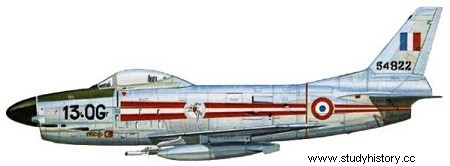
Commitments
During the Korean War, the Saber was the only fighter sufficiently capable and maneuverable against the opposing MiG-15s. However, the MiGs showed better performance in terms of climb rate and at high altitude, and had heavier armament. The training of American pilots, on the other hand, was clearly superior, although a number of MiG pilots were experienced former Russian fighter pilots who had participated in the Second World War. The exact number of victories is unknown, with each side citing different numbers. Thus, the Americans declare about 800 victories over the MiG-15s for a hundred Sabers lost on mission. For their part, the Soviets claimed to have lost 345 aircraft (this figure does not take into account the Chinese and North Korean losses) and proclaimed a victory ratio of 2 to 1 in their favor.
In 1958, several dogfights pitted Nationalist China's Sabers against Communist China's MiG-15s during the Second Taiwan Strait Crisis. The first air-to-air missile victory was witnessed on this occasion, when an AIM-9 Sidewinder fired by an F-86 Saber of the Republic of China Air Force shot down a MiG-15 of the People's Liberation Army on September 24, 1958.
Pakistan engaged its Saber during the conflicts with India in 1956 and 1971.
Argentina used their Sabers to counter a coup in 1962.
Portugal engaged its Sabers from 1961 to 1964, during the Guinea-Bissau War of Independence.
dates
 commissioning date:1950
commissioning date:1950
 end of use date:1980
end of use date:1980
Nationalities
Constructor :USA
Users :USA Canada
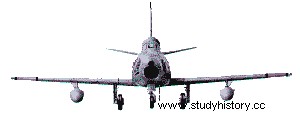
Categories Hunter
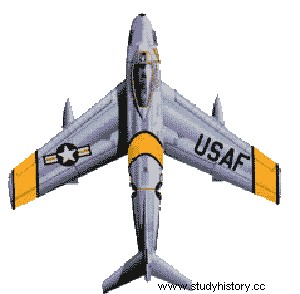
Technical and Performance Data
Wingspan:11.28m
Length:11.43m
Height:4.50m
Maximum weight:73059kg
Autonomy :840km
Maximum Speed :1,080 km/h
Practical ceiling :14650m
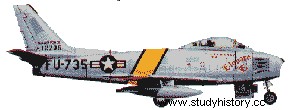
Motorisation (engines or reactors)
 1 General ElectricJ47-GE-13 2,400kg/p reacreator
1 General ElectricJ47-GE-13 2,400kg/p reacreator
Armaments
 defensive:6 x 12.7mm machine guns
defensive:6 x 12.7mm machine guns
